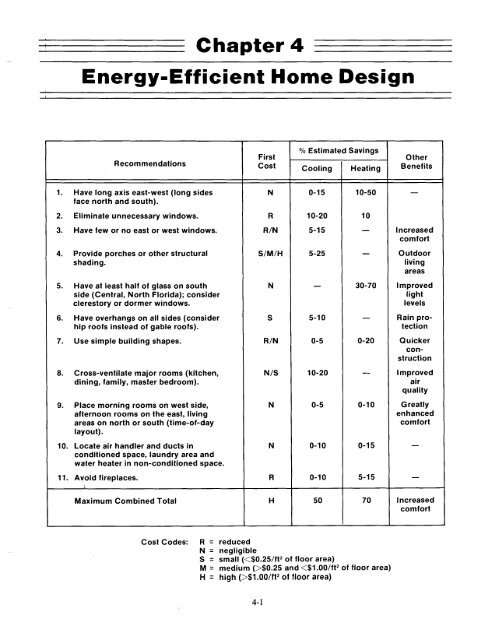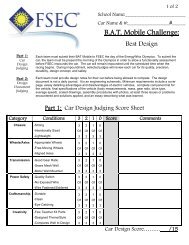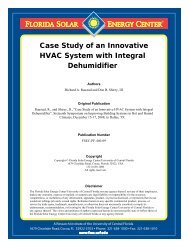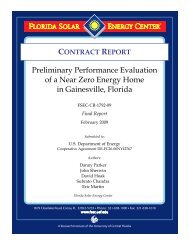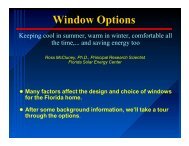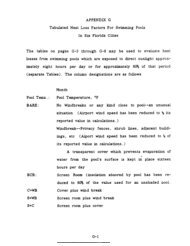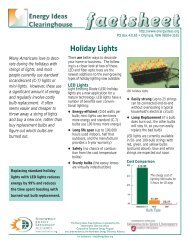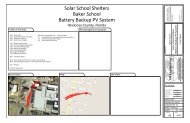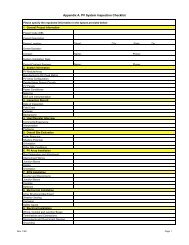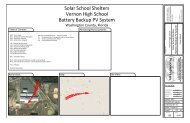Chapter 4 Energy-Efficient Home Design - Florida Solar Energy Center
Chapter 4 Energy-Efficient Home Design - Florida Solar Energy Center
Chapter 4 Energy-Efficient Home Design - Florida Solar Energy Center
Create successful ePaper yourself
Turn your PDF publications into a flip-book with our unique Google optimized e-Paper software.
<strong>Chapter</strong> 4<br />
<strong>Energy</strong>-<strong>Efficient</strong> <strong>Home</strong> <strong>Design</strong><br />
Recommendations<br />
1. Have long axis east-west (long sides<br />
face north and south).<br />
2. Eliminate unnecessary windows.<br />
3. Have few or no east or west windows.<br />
4. Provide porches or other structural<br />
shading.<br />
5. Have at least half of glass on south<br />
side (Central, North <strong>Florida</strong>); consider<br />
clerestory or dormer windows.<br />
6. Have overhangs on all sides (consider<br />
hip roofs instead of gable roofs).<br />
7. Use simple building shapes.<br />
8. Cross-ventilate major rooms (kitchen,<br />
dining, family, master bedroom).<br />
9. Place morning rooms on west side,<br />
afternoon rooms on the east, living<br />
areas on north or south (time-of-day<br />
layout).<br />
10. Locate air handler and ducts in<br />
conditioned space, laundry area and<br />
water heater in non-conditioned space.<br />
11. Avoid fireplaces.<br />
Maximum Combined Total<br />
First<br />
Cost<br />
Cost Codes: R = reduced<br />
N = negligible<br />
S = small ($0.25 and $1.00/ft2 of floor area)<br />
N<br />
R<br />
R/N<br />
S/M/H<br />
N<br />
S<br />
R/N<br />
N/S<br />
N<br />
N<br />
R<br />
H<br />
OIO Estimated Savings<br />
Cooling<br />
0-15<br />
10-20<br />
5-1 5<br />
5-25<br />
-<br />
5-1 0<br />
0-5<br />
10-20<br />
0-5<br />
0-1 0<br />
0-1 0<br />
I<br />
Heating<br />
10-50<br />
10<br />
-<br />
-<br />
30-70<br />
-<br />
0-20<br />
-<br />
0-1 0<br />
0-1 5<br />
5-1 5<br />
70<br />
Other<br />
Benefits<br />
-<br />
l ncreased<br />
comfort<br />
Outdoor<br />
living<br />
areas<br />
l mproved<br />
light<br />
levels<br />
Rain pro-<br />
tection<br />
Quicker<br />
con-<br />
struction<br />
Improved<br />
air<br />
quality<br />
Greatly<br />
enhanced<br />
comfort<br />
-<br />
-<br />
l ncreased<br />
comfort
Marketing <strong>Energy</strong>-Eff icient <strong>Home</strong> <strong>Design</strong><br />
Most home buyers are more concerned with the<br />
basic rooms a house contains than with its energy<br />
features. Nevertheless, you have an advantage over<br />
the competition by selling the potential buyer on the<br />
energy advantages of your home plans. Many<br />
energy features can be included at a negligible cost<br />
to you. Emphasize the comfort, convenience and<br />
savings they provide.<br />
Orientation is a key energy and comfort feature.<br />
<strong>Chapter</strong> 3 on site planning illustrates the discomfort<br />
of eating an early-evening meal in a dining room<br />
with west-facing glass or a west-facing porch,<br />
because of the sun's strong rays at that time of day.<br />
Examples like that will help you market the time-ofday<br />
layout concept discussed in this chapter. The<br />
avoidance of west windows can be marketed first<br />
from a comfort viewpoint, then from an energy<br />
viewpoint.<br />
Daily <strong>Solar</strong> Heat Gain for 118" Single Glass<br />
North South East Roof North South East Roof<br />
n.<br />
west<br />
A.<br />
"r<br />
West<br />
Glass facing norrh or south is preferable to<br />
glass facing east, west or roofward (horizontal).<br />
It is clear that north and south windows cause significantly<br />
fewer problems in summer than do east or<br />
west windows. Further, south windows are a<br />
benefit in winter. In North or Central <strong>Florida</strong>, you<br />
should promote the wintertime heating that the<br />
south-facing glass will provide - almost 2-1 /2<br />
times as much as the heating benefit of east or west<br />
windows. For this reason, south-facing glass should<br />
be clear, and shading should be provided by deciduous<br />
trees, overhangs (the calculation procedure in<br />
this chapter may be used to impress customers), and<br />
interior operable window treatments (shades or<br />
blinds). South-facing clerestory windows are an<br />
excellent means of providing light and winter heat to<br />
interior spaces - and in summer they receive only<br />
20% of the heat of a horizontal skylight! Additionally,<br />
the dramatic effect of a clerestory, from inside<br />
and out, may actually sell the house.<br />
The passive solar heating afforded by proper window<br />
orientation can be best utilized if it can be<br />
(1 ) distributed (via lots of openings between rooms)<br />
and (2) stored for use at night. The heat storage<br />
ability (capacity) or "thermal mass" of the house<br />
depends on the components it is made with. The<br />
following components have good heat storage ability<br />
and are referred to as being "massive":<br />
a quarry tile concrete slab floor<br />
a concrete block or brick interior partition wall<br />
a concrete block exterior wall insulated on the<br />
outside.<br />
Ceramic or quarry tile flooring is the most marketable<br />
feature, particularly in a high-end home. See<br />
<strong>Chapter</strong>s 5 and 6 for more details on marketing the<br />
thermal mass.<br />
Natural ventilation is a key energy-saving strategy<br />
for <strong>Florida</strong> homes. Unfortunately, many stock<br />
house plans do not provide for cross-ventilation and<br />
will require modifications. If you have selected or<br />
modified plans that permit cross-ventilation, market<br />
them from the perspective of energy savings, "natural<br />
living" and fresh air. Combined with the effects<br />
of thermal mass and ceiling fans, the airconditioning<br />
savings from natural ventilation can be<br />
10-40%.<br />
Porches are desirable to many home buyers, so why<br />
not incorporate one in your home plans from the<br />
start? This way, the porch roof can be continuous<br />
and there can be a radiant barrier and a vented attic<br />
above the porch (techniques described in <strong>Chapter</strong><br />
8). Point out that a porch on the east or south side<br />
provides a shaded, breezy haven during the heat of<br />
late summer afternoons and evenings. Consider<br />
more than one porch for larger homes. On starter<br />
or retirement homes, explore the market (and cost)<br />
trade-off of a porch vs. the extra bedroom - or<br />
make the porch an option. Since a porch is far better<br />
than a fireplace in terms of energy savings,<br />
encourage the choice of the porch by asking home<br />
buyers which they will use more.
Selecting and Modifying - <strong>Home</strong> Plans<br />
for ~ nerg~ ~fficienci<br />
The rest of this chapter describes energy-efficient A house plan which has a narrow front is best for a<br />
features to look for in a home plan, and provides site which faces east or west. Many zero lot line and<br />
examples that will help you visualize "putting it all other narrow front plans are now available.<br />
together."<br />
1. Have long axis east-west<br />
The best time to start thinking of this is in the subdi-<br />
vision and site planning stage. However, most sites<br />
will accommodate a house oriented in this fashion<br />
- that is, with its long sides facing north and south.<br />
Suppose a 1500-square-foot house and a 500-<br />
square-foot garage were going on a site. If the site<br />
faces north or south and is a 100-foot by 100-foot<br />
lot. a conventional solution is:<br />
Narrow house shape is best for<br />
east- or west-facing lots.<br />
Side-entry garages can help relieve the impression of<br />
the garage dominating the street side elevation.<br />
Other specific solutions to west fronts and east fronts<br />
are covered in examples at the end of this chapter.<br />
2. Eliminate unnecessary windows<br />
Windows generally represent a source of significant<br />
heat gain in summer and significant heat loss in win-<br />
Ideal orientation of a <strong>Florida</strong> house. ter. Proper orientation of the windows and selection<br />
Or on a 75-foot by 100-foot lot which can not have<br />
more than a 54-foot-wide footprint:<br />
Orientation for standard size lots.<br />
of appropriate glass (see <strong>Chapter</strong> 7) can partially<br />
alleviate the problem. However, excessive glass may<br />
not be adding much value to the home. As a gen-<br />
eral rule, 15% of the floor area given to well-spaced<br />
windows will provide a well-lit interior. But if you<br />
give that much or more percentage to windows,<br />
make sure the glass is well shaded and/or consider<br />
more elaborate window products (see <strong>Chapter</strong> 7).<br />
<strong>Home</strong>s can be attractive with 10% or less of floor<br />
area as window glass, and some builders are finding<br />
that the initial cost-savings of fewer windows can<br />
provide an edge on the competition. Choose plans<br />
that have a few well-placed windows in terms of<br />
view, appearance and energy considerations instead<br />
of many randomly placed windows.
3. Have few or no east or west windows<br />
For a north- or south-facing lot, there are a number<br />
of plans which omit side windows that face east or<br />
west. An obvious alternative is to place a garage or<br />
carport on one of these sides<br />
of the house. For east- or Porch]<br />
west-facing lots, choose house<br />
plans that have just one front<br />
window and one or more<br />
porches (back and front).<br />
windows windows<br />
I 1-<br />
Porch to<br />
One or no windows<br />
(Front of house)<br />
Avoid unshaded east- or west-facing windows.<br />
4. Provide porches or other<br />
structural shading<br />
Since east and west windows have significantly<br />
more solar heat gain in summer than north or south<br />
windows, permanent window shading using porches<br />
or building shape is desired. Shading from the west<br />
sun is even more important than from the east sun,<br />
due to the time of day. Keep buffer spaces (closets,<br />
the garage, etc.) on the east and west sides.<br />
A porch provides a place for the home's occupants<br />
to eat and even cook outdoors, assuming it is shady,<br />
breezy and insect-free. Since heat from food and<br />
bodies remains outside, a porch can be an important<br />
energy saver worth looking for in home designs. To<br />
encourage the use of the porch for outdoor dining,<br />
choose a home plan that incorporates the following<br />
design criteria.<br />
------- 1<br />
I<br />
Screen I<br />
porch I<br />
I<br />
wbE<br />
*<br />
s<br />
This north-facing porch will be shaded<br />
from summer evening sun.<br />
Selecting and Modifying <strong>Home</strong> Plans<br />
Orient the porch so it is shaded in the evening in<br />
summer. The east and south sides are first<br />
choices. A north-facing porch will receive direct<br />
sun from the northwest, so an "L" to the west is<br />
required for shading (see drawing). A west-facing<br />
porch can provide nice shade for the house but<br />
Place a porch on east and west sides.<br />
will probably not be used in the evening. Having<br />
two porches - one on the east side and one on<br />
the west side - assures a shady porch is available<br />
all day long.<br />
Have direct access from the kitchen to the porch.<br />
Having to carry dishes through a dining room or<br />
family room discourages the frequent use of a<br />
porch for dining. Atrium (French) or sliding<br />
glass doors directly to the porch will provide<br />
added convenience.<br />
C<br />
Opening from another room 7<br />
1 KITCHEN - 1<br />
16x12<br />
0 0<br />
0 0<br />
KITCHEN<br />
Iool<br />
SCREEN I<br />
PORCH I<br />
r<br />
- - r--3--7<br />
I<br />
I<br />
I<br />
4<br />
SCREEN I<br />
PORCH<br />
h<br />
.--1--3--A<br />
Convenient access from kitchen<br />
to porch is desirable.<br />
I<br />
I<br />
I
Selecting and Modifying <strong>Home</strong> Plans<br />
Make sure the porch will be cross-ventilated. in two conventional ways. One is to use a good<br />
Three open sides is best. In some cases, open conducting material on the slab floor (tile or slate,<br />
house windows will permit cross-ventilation of a for example) and the other is to use concrete block<br />
porch. A ceiling fan can help people feel cool. or brick partition walls. For every square foot of<br />
south glass, there should be 30 Btu (British Thermal<br />
Unit, a unit of energy) per OF of storage. A 4-inch<br />
slab floor has 8 Btu/OF per square foot. An 8-inch<br />
block wall has 30 Btu/OF per square foot of wall<br />
area. So, glass area (GA) = partition wall block area<br />
+ (4/15 x tiled concrete slab floor area). Another<br />
way of putting that is: use 3.75 square feet of<br />
exposed slab for each square foot of south-facing<br />
glass.<br />
For example, suppose you wanted to use a house<br />
design with 300 square feet of glass and you modi-<br />
fied it so 200 square feet of glass was on the south<br />
side. You would then want one of the following:<br />
200 square feet of 8-inch block partition wall (25<br />
feet of 8-foot-high wall)<br />
750 square feet of tiled floor (See <strong>Chapter</strong> 5 for<br />
other options)<br />
a combination such as 100 square feet of block<br />
wall and 375 square fcet of tiled area.<br />
Another alternative is to use containers of water as<br />
wall dividers. There are cylindrical containers<br />
designed for this purpose, and the water can be dyed<br />
for an aesthetic effect. Water provides 62 Btu per<br />
Install ceiling fans on porches. cubic foot (8 Btu/gallon = 1 ~tu/~ound).<br />
Keep the roof of the porch cool. Use a ventilated<br />
attic space and a radiant barrier over the porch as<br />
described in <strong>Chapter</strong> 8.<br />
Other structural shading techniques can be provided.<br />
Overhangs (described later in this chapter) are<br />
important. In two-story homes, use designs which<br />
provide overhangs or other shading for first-floor<br />
windows. North-facing windows are best shaded by<br />
adjacent projections, such as a garage that sticks out.<br />
Recessing the windows on the north side is another<br />
good shading method.<br />
5. Have at least half of glass<br />
on south side<br />
As illustrated by the chart in the marketing section,<br />
south-facing glass receives significant winter sun and<br />
much less summer sun. In North and Central<br />
<strong>Florida</strong>, use south-facing windows to provide heat in<br />
winter. Place the main living area on the south side.<br />
Elements of successful<br />
passive solar heating for <strong>Florida</strong><br />
Combine all elements to use the<br />
sun's heat in winter.<br />
Provide heat storage in the house to prevent over- With concrete block construction, use block walls<br />
heating. In frame houses on slabs, this can be done with R-1 1 exterior insulation (see <strong>Chapter</strong> 6).
Percent<br />
Heating<br />
Savings<br />
30<br />
40<br />
50<br />
6 0<br />
70<br />
Selecting and Modifying <strong>Home</strong> Plans<br />
Heating Savings for a Well-Sealed <strong>Home</strong> with R11 Walls,<br />
Double Glass Windows and High Mass<br />
North <strong>Florida</strong><br />
(R30 ceiling insulation)<br />
Required south glass<br />
as percentage of<br />
conditioned floor<br />
space<br />
5.3<br />
8.1<br />
11.5<br />
Not recommended<br />
Not recommended<br />
Required exposed<br />
slab floor area as<br />
percentage of con-<br />
ditioned floor space<br />
20<br />
3 1<br />
43<br />
Not recommended<br />
Not recommended<br />
Also, use openable windows, not fixed glass, as a<br />
backup to prevent overheating. Position the house<br />
on the site so the south windows will not be shaded<br />
by adjacent buildings or evergreen trees.<br />
How much energy can you save by doing this? That<br />
depends, of course, on the house itself and the<br />
number of people occupying it. For a family of<br />
four, the preceding table shows the percentage of<br />
heating saved for different fractions of glass area.<br />
Starting in the design stage, the only extra cost of the<br />
passive solar heating is a floor finish that will permit<br />
the concrete slab to be exposed for use as a thermal<br />
mass. The energy conservation measures are the<br />
equivalent of the baseline house in the energy code<br />
(including at least Level 2 air-tightening and doublepane<br />
windows). And it is no more costly to situate<br />
glass on the south side. Trying to provide more than<br />
50% heating savings may not be cost-effective due to<br />
the required window area.<br />
There are also some initial cost savings in providing<br />
a passive solar heating design. You may be able to<br />
substitute electric strip heat for a heat pump. Heat<br />
will be required primarily during very cold nights<br />
(when a heat pump would rely mainly on electric<br />
resistance heat anyway) or cold overcast periods<br />
(infrequent in <strong>Florida</strong>).<br />
In <strong>Florida</strong>, solar heating is secondary to cooling. Do<br />
not add window area for the sake of heating.<br />
Instead, shift window area from east and west sides<br />
to the south side.<br />
DO not use attached "sunrooms" or greenhouses that<br />
have overhead glass. This glass receives too much<br />
sun in summer, is difficult to shade, and is not<br />
openable.<br />
Central <strong>Florida</strong><br />
(R19 ceiling insulation)<br />
Required south glass<br />
as percentage of<br />
conditioned floor<br />
space<br />
3.3<br />
5.1<br />
7.2<br />
9.8<br />
13.3<br />
Required exposed<br />
slab floor area as<br />
percentage of con-<br />
ditioned floor space<br />
12<br />
19<br />
27<br />
37<br />
50<br />
Clerestory or Dormer Windows. Look into designs<br />
which have north-facing or south-facing clerestory<br />
or dormer windows. These windows can provide<br />
daylight to interior spaces at a fraction of the heat<br />
gain of skylights (and with less chance of leaking<br />
rain). They can provide a dramatic effect inside and<br />
out which may help you sell the home. Clerestory<br />
windows should be operable (awning-type or<br />
hopper-type) to provide a secure ventilation outlet.<br />
If operable, they can be used to ventilate a room<br />
that otherwise would not have cross-ventilation.<br />
South-facing clerestory windows can be used to<br />
provide solar heating to rooms on the north side (see<br />
end-of-chapter examples). Moreover, because the<br />
direction of the slope of a shed roof is unlike that of<br />
a normal overhang, all south-facing clerestory win-<br />
dows can be used for winter heat gain and still be<br />
totally shaded in summer from the direct sun (as<br />
shown on next page).<br />
Clerestory windows can provide<br />
shaded daylight.
6. Have roof overhangs<br />
Search for house plans that provide overhangs on all<br />
sides of the house (hip roof). Make certain that the<br />
roof is oriented along an east-west axis if the plan<br />
calls for a gable roof. The resultant overhang on the<br />
south side will shade all direct sun during the<br />
summer. The ideal length of an overhang on the<br />
south side of a house is dependent on three factors:<br />
the latitude of the location<br />
the time of year shade is desired<br />
the distance between the soffit and the bottom of<br />
the glass.<br />
It is quite simple to calculate the ideal length of a<br />
horizontal south overhang using the table below.<br />
7-<br />
D<br />
L<br />
The length (L) of a south-facing overhang<br />
can be determined by knowing the<br />
sill-to-soffit distance (D).<br />
Latitude<br />
25"<br />
26'<br />
27"<br />
28'<br />
29"<br />
30°<br />
31"<br />
Location<br />
The Keys<br />
Miami<br />
Jupiter<br />
Tampa<br />
New Smyrna<br />
Beach<br />
Panama<br />
City<br />
Graceville<br />
Overhang <strong>Design</strong> for South-facing Windows<br />
Sun Angles<br />
a b<br />
41.5<br />
40.5<br />
39.5<br />
38.5<br />
37.5<br />
36.5<br />
35.5<br />
52.5<br />
54.0<br />
53.5<br />
57.0<br />
58.5<br />
60.0<br />
61.5<br />
Factor<br />
(F)<br />
.77<br />
.73<br />
.69<br />
.65<br />
.61<br />
.58<br />
.54<br />
Selecting and Modifying <strong>Home</strong> Plans<br />
For south-facing clerestory windows, the roof which<br />
will shade the window is often rising and the multi-<br />
plication factors are less appropriate. Therefore, sun<br />
angles a and b are also shown for each city. The<br />
point where a and b cross is the ideal location for<br />
the end of the roof as shown. Draw the roof line,<br />
window, and angles a and b to scale to determine<br />
this point.<br />
Although all overhang factors are for south-facing<br />
surfaces only, overhangs can be effective in shading<br />
all sides from diffuse sunlight. However, unlike the<br />
south side, "direct beam" solar heat will fall on an<br />
east, west or north side under an overhang due to<br />
the low angle of the sun. Use overhangs as wide as<br />
practical on north, east and west sides.<br />
Angle a is Dec. 21 sun, angle b is end of winter<br />
(see table below for dates).<br />
~i~~ of year ~<br />
Shaded from<br />
~ Length ~ of Overhang ~ l (L= l DxF) for ~<br />
Sill-to-Soffit Distance (D) of:<br />
Direct Sun 4' 5' 6' 7' 8'<br />
Feb 17 - Oct 24 3.1' 3.9' 4.6' 5.4' 6.2'<br />
Feb 24 - Oct 16<br />
Mar 5 - Oct 7<br />
2.9'<br />
2.8'<br />
3.7'<br />
3.5'<br />
4.4'<br />
4.1'<br />
5.1'<br />
4.8'<br />
5.8'<br />
5.5'<br />
Mar 7 - Oct 5<br />
Mar 16 - Sep 27<br />
2.6'<br />
2.4'<br />
3.3'<br />
3.1'<br />
3.9'<br />
3.7'<br />
4.6'<br />
4.3'<br />
5.2'<br />
4.9'<br />
Mar 21 - Sep 21<br />
Mar 30 - Sep 13<br />
2.3'<br />
2.2'<br />
2.9'<br />
2.7'<br />
3.5'<br />
3.2'<br />
4.1'<br />
3.8'<br />
4.6'<br />
4.3'
7. Use simple building shapes<br />
A rectangular-shaped home oriented on an east-west<br />
axis is the best design for energy efficiency. A<br />
square is better than a rectangle oriented north-<br />
south. <strong>Design</strong>s which have a large amount of exte-<br />
rior wall area should be avoided.<br />
However, windows are more important than walls.<br />
An extra "jog" in the house shape to permit a win-<br />
dow to face north or south instead of east or west<br />
will usually be a good trade-off and result in lower<br />
year-round energy use. Also, cross-ventilation of<br />
rooms lends itself nicely to spread-out, one-room-<br />
deep houses. If properly designed, the benefits of<br />
good cross-ventilation and orientation should out-<br />
weigh the extra energy load imposed by slightly<br />
more wall area.<br />
Two-story designs have more wall area and less<br />
floor and roof area than simple one-story designs.<br />
They are also more difficult to shade with landscap-<br />
ing. Therefore, consider using better-insulated walls<br />
on two-story designs. Two-story home designs fre-<br />
quently can be modified easily for adequate<br />
cross-ventilation.<br />
8. Cross-ventilate rooms<br />
Before vapor-compression air conditioning, natural<br />
ventilation kept homeowners cool. <strong>Florida</strong> houses<br />
were built with wide porches and large windows.<br />
The principles inherent in these older homes can be<br />
applied to contemporary ones. New homes can also<br />
be designed with massive materials to "store" the<br />
cooling provided by night-time ventilation and use it<br />
the next day to augment air conditioning.<br />
The key to natural ventilation design is allowing<br />
openings for the air to enter and leave the home.<br />
Allow openings for air to enter and<br />
leave the home.<br />
Selecting and Modifying <strong>Home</strong> Plans<br />
Ideally, all rooms should be cross-ventilated. This<br />
includes bedrooms when their doors are shut. How-<br />
ever, the major living, eating, sleeping and food<br />
preparation areas are most important. The kitchen<br />
is a source of much heat (from the refrigerator<br />
motor, dishwasher, oven, stove and microwave), so<br />
choose designs where the kitchen is well-vented.<br />
Keep the following general ventilation rules in mind<br />
when choosing or modifying plans:<br />
It is best to have equal inlet and outlet areas.<br />
Ideally, about 12% of the floor area should have<br />
screened openings. For second floors, 10% is<br />
adequate. If this is all met by sliding or single- or<br />
double-hung windows where 55-60% of the win-<br />
dow is fixed, excessive window area would be<br />
required. To keep glass area to a minimum, use<br />
screen front doors, atrium-style doors to screened<br />
porches, and fully operable window types such as<br />
casements and awnings to provide the required<br />
openings.<br />
Openings on adjacent walls should be located as<br />
far away from one another as possible.<br />
1<br />
Bedroom<br />
Adjacent wall openings should be at<br />
opposite ends.<br />
Airflow is better with a screened balcony or<br />
porch than with window screens on the doors or<br />
windows.<br />
,<br />
Window<br />
screens<br />
on balcony<br />
Ventilation is improved by having screened<br />
porches or balconies instead of<br />
window screens.
Roof cupola<br />
' Part wall<br />
louvered at top<br />
Roof cupolas can aid ventilation<br />
regardless of wind direction.<br />
Roof cupolas can aid ventilation, as can clerestory<br />
windows (however, clerestory windows open dur-<br />
ing the day may bring in hot air off the roof).<br />
Low inlets are preferred for occupant comfort.<br />
Therefore, screened doors and low windows are<br />
preferred from a ventilation viewpoint.<br />
In two- or three-story structures, there will be a<br />
slight benefit from high outlets if air is permitted<br />
to flow from the first floor up to the higher levels.<br />
Mass will provide daytime cooling from night<br />
venting. It is best to locate exposed (uncarpeted)<br />
floors and massive walls in living, dining and kit-<br />
chen areas, leaving bedrooms with less mass so<br />
that they can be quickly cooled in the evening.<br />
For homes with massive walls or floors to store<br />
Massive wall<br />
Massive floor<br />
Locate openings close to massive wall or floor.<br />
+<br />
Selecting and Modifying <strong>Home</strong> Plans<br />
Ventilation<br />
+ pattern, wind<br />
from left<br />
+ , Wind from<br />
Clerestory windows can aid ventilation but may<br />
bring in hot air from the roof<br />
during the day (wind from right).<br />
the heat (or coolness), inlets should be positioned<br />
close to the mass to create a wall or floor "jet."<br />
In rooms with one outside wall, two widely<br />
spaced windows are better than one large<br />
window.<br />
Wingwalls (walls that protrude out from the<br />
house, next to the window) can be used to<br />
improve ventilation. A wingwall should be as<br />
long as the window is wide. It can increase air-<br />
flow, particularly in rooms with windows on only<br />
one wall. Appropriate uses of wingwalls are<br />
shown on the next page. In some instances, the<br />
space between the wingwalls can be used as<br />
indoor or outdoor closet space. Casement win-<br />
dows can act as wingwalls too (see <strong>Chapter</strong> 7).<br />
Range of wind<br />
directions for which Perspective<br />
room is effectively<br />
ventilated<br />
140"<br />
Wingwalls direct air into the house.
Selecting and Modifying <strong>Home</strong> Plans<br />
Openings on Openings on<br />
same wall adjacent wall<br />
#4. Poor<br />
#5a. Best<br />
#6a. Best<br />
Key to symbols<br />
Shaded area indicates wind directions (from circumference to center)<br />
@ whereby airspeed would be increased.<br />
Wingwall examples<br />
4-10<br />
J
9. Time-of-day layout<br />
Time-of-day layout refers to locating rooms where<br />
they will provide the most comfort when in use.<br />
Many <strong>Florida</strong> residents are hesitant about having a<br />
west-facing kitchen, dining room or porch because<br />
of the discomfort they experience while preparing<br />
and eating their evening meal. Time-of-day use can<br />
vary from one family to another, but the following<br />
table shows generally preferred locations for most<br />
rooms. <strong>Energy</strong> savings can be realized in summer,<br />
since residents will not be discomforted by hot wall<br />
surfaces or penetrating sun and therefore will not<br />
reset their air conditioner thermostat to compensate.<br />
Similarly, having the living area on the south or<br />
open to south-facing rooms will provide winter heat-<br />
ing savings and comfort.<br />
Kitchen<br />
Dining<br />
Garage<br />
Covered<br />
porches<br />
Baths<br />
Closets<br />
North<br />
East<br />
South<br />
West<br />
N<br />
S<br />
W<br />
E<br />
E<br />
W<br />
E<br />
E<br />
E<br />
S<br />
W<br />
E<br />
S<br />
N<br />
N<br />
N<br />
S<br />
N<br />
4-1 1<br />
Selectins and Modifying <strong>Home</strong> Plans<br />
Garage<br />
Dining<br />
Room layouts designed for occupant comfort.<br />
Base choice on direction of eveninglnight<br />
breezes. If late morning sleeping is antici-<br />
pated, west may be better than east.<br />
provided, family room is more important;<br />
most living rooms are rarely used.<br />
Clock Time-of-Day When Direct Sun Strikes Unshaded House<br />
(July corrected for Daylight Saving Time)<br />
- -<br />
Eastern <strong>Florida</strong><br />
I Western <strong>Florida</strong><br />
(Jacksonville, Miami, Orlando)<br />
Tallahassee<br />
Pensacola<br />
January July<br />
(Central Time Zone)<br />
Never<br />
7:15-12:30<br />
7:15-5:45<br />
12:30-5:45<br />
S<br />
W<br />
N<br />
S<br />
6:40-1O:OO<br />
and<br />
5:OO-8:20<br />
6:40-1:30<br />
10:OO-5:OO<br />
1 :30-8:20<br />
W<br />
W<br />
Provides a buffer to rest of house.<br />
West should be avoided if evening meals<br />
are expected to be eaten on porch.<br />
Provides a buffer to rest of house.<br />
Provides a buffer to rest of house.<br />
Add<br />
15 minutes<br />
to all times<br />
at left<br />
Subtract<br />
30 minutes<br />
from all times<br />
at left
10. Locate air handler and<br />
appliances properly<br />
Look for designs which can contain the air handler<br />
for non-combustible furnaces, together with all<br />
ductwork, in the conditioned space. This is a big<br />
asset in reducing air infiltration and duct losses.<br />
Modify designs, if necessary, to put the air handler<br />
where a coat closet or basement stairs are shown,<br />
and think of potential layouts for the ductwork in<br />
the conditioned space.<br />
Washers, dryers and water heaters can be a source<br />
of heat and/or moisture to the house. Since air<br />
conditioning is a greater concern than heating in<br />
<strong>Florida</strong>, enlarge garages, carports, or closets off of a<br />
porch to provide non-conditioned space for these<br />
appliances. Vent the dryer to the outdoors.<br />
Selecting and Modifying <strong>Home</strong> Plans<br />
11. Avoid fireplaces<br />
Fireplaces are a source of air leakage, whether or<br />
not they are being used. It would be best to omit<br />
fireplaces from plans. If they are to be installed, see<br />
<strong>Chapter</strong> 11 for how best to install them.<br />
Summary<br />
The choice of home design can greatly affect the<br />
energy use and comfort of the home owner. Proper<br />
orientation, fewer window areas, and structural<br />
shading can all help keep out some of the sun's heat.<br />
Glass should face north or south unless facing a<br />
porch. Overhangs should be correctly sized for<br />
shading direct sun from south-facing glass and<br />
should be used on all sides of the house. Simple<br />
building shapes are preferred but shading and venti-<br />
lation may dictate an irregular shape. All major<br />
rooms should be cross-ventilated, and located where<br />
they will provide the most comfort to occupants.<br />
Choose plans which locate laundry appliances in the<br />
garage and air handlers for non-combustible<br />
furnaces in the conditioned space. Consider the<br />
energy disadvantages of a fireplace.
House Plan Examples<br />
Do not expect to readily find a home design that<br />
incorporates all of this chapter's recommendations<br />
and works well with the site you have selected. So<br />
that you can see how the preceding recommenda-<br />
tions can be carried through into the house design,<br />
this section includes examples of homes for sites<br />
oriented to the north, south, east or west. If your<br />
site faces a different direction (northwest, for exam-<br />
ple), it would be best to orient the house so that the<br />
two sides with the most windows face within 15O of<br />
north or south. Two of the examples shown here,<br />
however, are site-independent - that is, most glass<br />
is well shaded regardless of orientation. Also, there<br />
are two multi-family examples, three zero-lot-line<br />
detached home examples, and eight orientation-<br />
dependent detached home designs.<br />
Each example here is just that, an example; full<br />
plans are not available. If you would like to build<br />
one of the examples, take the drawing to an archi-<br />
tect or residential designer. To maintain the energy<br />
aspects of the design, do not alter window or outside<br />
wall locations.<br />
FSEC has other home designs available with full<br />
construction drawings. The designs are winners<br />
of state-wide competitions. Contact FSEC for<br />
more information.<br />
Most single-family home designs shown here have a<br />
screened front door and a two-car garage. In most<br />
instances, a one-car garage or carport could be sub-<br />
stituted. (A carport permits breezes to enter the<br />
home and is preferred.)<br />
8/0 1 /90<br />
Four-inch walls are shown on most designs. Block<br />
walls could be substituted. All dimensions are<br />
rounded to the nearest foot.<br />
Less common abbreviations and symbols used<br />
in the examples are defined below:<br />
Abbr./Symbol Meaning<br />
AH<br />
C<br />
L<br />
P<br />
R<br />
WIC<br />
WO<br />
-<br />
//////<br />
Air handler for cooling1<br />
heating system<br />
Air conditioner<br />
compressor<br />
Linen closet<br />
Pantry closet<br />
Refrigerator<br />
Walk-in closet<br />
Wall oven<br />
Roof overhang or<br />
screened porch wall<br />
Fence or railing<br />
The plans are numbered with prefix abbreviations<br />
for quick identification. For example, SF is<br />
South-Facing.
Orientation-independent plans<br />
<strong>Home</strong> plans that are adaptable to many lots regard-<br />
less of orientation should emphasize shading glass<br />
areas and avoid a disproportionate number of<br />
unshaded windows on any one side. Example 01-1<br />
is a plan similar to many being built today, but with<br />
better shading provided. Front and back porches<br />
structurally shade most of the glass. A few<br />
unshaded windows remain - one in the front (mas-<br />
ter bath), two on one side (family room and second<br />
bath), one on the other side (bedroom 2) and one on<br />
the back (bedroom 1) - but overhangs and other<br />
shading devices (<strong>Chapter</strong> 7) can help protect them.<br />
Ventilation of the main living areas, kitchen and<br />
master bedroom is possible. Bedrooms 2 and 3<br />
require additional openings for ventilation when the<br />
doors are closed.<br />
MASTER<br />
BEDROOM<br />
12x15<br />
------7-<br />
SCREENED<br />
PORCH<br />
1690 SQ. FT<br />
House Plan Examples<br />
Example 01-2 is reminiscent of older <strong>Florida</strong><br />
homes, with a porch or veranda on all sides. High,<br />
narrow loft windows provide light and good<br />
ventilation.<br />
rr-- '---'---'---'--'---'---- -------<br />
- 8- 40' -<br />
1<br />
I<br />
u i "7<br />
8' i SCREENED PORCH<br />
I<br />
LL ------a---L------ &<br />
SCREENED PORCH<br />
I I<br />
1744 SQ. FT.<br />
Plan 01-1 Plan 01-2<br />
--------- A
North-facing single family home plans<br />
North-facing sites may be the best orientation for an<br />
energy-efficient, comfortable home. Example NF- 1<br />
shows a two-story plan with thick block walls indi-<br />
cating space for exterior insulation. Note that the<br />
overhanging second floor balcony shades the first-<br />
floor south-facing glass. There is no unshaded west<br />
glass. The <strong>Florida</strong> room should remain unconditi-<br />
oned and can serve as a screened porch in summer.<br />
North-facing glass is shaded from direct sun by the<br />
projections. Walls create wingwall effects for venti-<br />
lation in bedrooms 2 and 3. All rooms have good<br />
ventilation potential.<br />
1290 SQ. FT.+<br />
'Q 240 50. KT. <strong>Florida</strong> room<br />
680 SQ. FT.<br />
Plan NF-1, 1st floor<br />
Plan NF-1. 2nd floor<br />
House Plan Exam~les<br />
Plan NF-2a is a simple, small rectangular plan with<br />
a hip roof and two-car garage that will fit on most<br />
lots. Shading on the west side is provided by the<br />
garage and a screened porch. Tinted glass or an<br />
alternate shading method should be used on the<br />
three small east windows. Closets in bedrooms 2<br />
and 3 act as wingwalls. Cross-ventilation potential<br />
for each room is good.<br />
17x1 4<br />
Q 1275 SO. FT.<br />
N<br />
Plan NF-2a<br />
SCREENED 1)<br />
PORCH<br />
Plan NF-2b varies slightly from NF-2a. It adds wall<br />
area but reduces shading problems for the east win-<br />
dows, while maintaining reasonable cross-ventilation<br />
potential. A different interior layout is shown in the<br />
south-facing plan SF-2, which would also be effec-<br />
tive on north-facing lots.<br />
i~~ 1275 SO. FT<br />
N<br />
Plan NF-2b
House Plan Examples<br />
South-facing single family home plans windows provide light, winter heat and ventilation<br />
<strong>Energy</strong>-efficient designs are easily adapted to southfacing<br />
home sites. A front overhang is recommended<br />
with few or no side windows. Example<br />
SF-1 shows east and west windows, but they are<br />
shaded by long overhangs on the west and a<br />
screened porch on the east. All rooms have good<br />
ventilation potential. The south-facing clerestory<br />
to the main living area.<br />
Plan SF-2 is the same as NF-2b except that an alternate<br />
room arrangement is shown. There is direct<br />
access from the kitchen to the porch. The mirror<br />
image of this plan would also be effective for southfacing<br />
lots.<br />
I<br />
I<br />
I<br />
I<br />
1<br />
I<br />
I<br />
I<br />
I<br />
I<br />
L<br />
1670 SQ. FT.<br />
EAST ELEVATION<br />
SOUTH ELEVATION<br />
Plan SF-1<br />
W&E 1275 SO. FT.<br />
s<br />
Plan SF-2
West-facing home plans<br />
As previously discussed, the west is the worst side<br />
for glass. Choose designs which have one or no<br />
front windows, and which have a long porch on the<br />
back to shade the house from the morning sun.<br />
Finding an energy-efficient west-facing plan is a<br />
challenge, but many design options are available -<br />
although they may require modifications to an exist-<br />
ing plan.<br />
Keep house oriented on east-west axis. Put<br />
design emphasis on roof elevation and consider<br />
side-entry garages.<br />
Consider a house shape other than a simple rec-<br />
tangle to permit north- and south-facing glass and<br />
adequate ventilation. Examples: a 7-shape,<br />
U-shape, H-shape.<br />
Choose shapes with most windows on side.<br />
Plan WF-la<br />
House Plan Examples<br />
Use a large, covered front porch to shade win-<br />
dows. Consider a Victorian or country design to<br />
make the front porch a marketing feature.<br />
Plan WF-la is a U-shaped plan that uses the garage<br />
and front porch to shade the house from the sun.<br />
The shape permits cross-ventilation for every room.<br />
If a longer front elevation is desired, a larger front<br />
and back porch can provide the needed shade, as<br />
shown in plan WF-1 b.<br />
Plan WF-2 has no front windows and will provide<br />
excellent cross-ventilation to each room with<br />
southeast winds (a predominant wind direction in<br />
many parts of the state).<br />
L - - - - - - - - -J<br />
Plan WF-1 b<br />
1520 SQ. FT.<br />
r------------7<br />
I<br />
SCREENED<br />
PORCH<br />
I<br />
1<br />
1360 SQ. FT<br />
Plan WF-2
East-facing home plans<br />
The design criteria listed for west-facing plans will<br />
be energy-efficient on east plans also. However,<br />
east-facing lots present the most difficult challenge in<br />
selecting comfortable and energy-efficient floor<br />
plans. Not only does the back of the house have to<br />
be shaded, but the ideal focal point of the property<br />
should be shifted from the traditional back yard to a<br />
side yard to avoid the afternoon heat. A C-shape<br />
(or reverse C-shape) house with most glass on its<br />
sides, but not in front or back, will create a pleasant<br />
outdoor area, as shown in examples EF-1 and EF-2.<br />
Plan EF-1 succeeds in having no windows on the<br />
back of the house and an outdoor focal point on the<br />
south side. Due to the projection of the master bath<br />
wing, occupants can eat in the shade in the screened<br />
area during late afternoon and early evening in<br />
summer. The south side is also the best location for<br />
a pool. The south glass will help heat the home in<br />
winter. Every room except bedroom 3 has cross-<br />
ventilation potential, although the garage may block<br />
southeast breezes.<br />
sGN 1460 50. FT.<br />
E<br />
House Plan Exam~les<br />
Plan EF-2 maximizes cross-ventilation potential and<br />
the use of south glass, for an energy-efficient plan.<br />
There is one front-facing east window and one small<br />
(4 square-foot) west window. The south-facing cle-<br />
restory windows provide light and winter heat for<br />
the kitchen, living room, foyer and one bath. A<br />
north porch allows outdoor living/eating off the kit-<br />
chen and living room, and either the north or south<br />
side can serve as an outdoor focal point. Tile floor-<br />
ing provides thermal mass for ventilation and<br />
passive solar heating.<br />
Plan EF-1 Plan EF-2<br />
s<br />
* South facing<br />
clerestory<br />
2202 SQ. FT.
Zero lot line plans<br />
In areas where land costs are high, many builders<br />
use high-density detached house zoning. A typical<br />
lot size is 50 by 100 foot. Usually one side of the<br />
house is built on the lot line and is without win-<br />
dows. Glass is provided on the other three sides.<br />
Plan ZL-1 is best for east- or west-facing lots. Most<br />
of the glass is concentrated on the south side. Cross-<br />
ventilation potential is excellent. The open-air<br />
atrium (screened roof) helps provide ventilation and<br />
light to the kitchen and master bath, and the<br />
screened porch and covered patio help shade other<br />
glass. Yro'1<br />
- so<br />
Plan ZL-1<br />
40'-<br />
" 1170 SQ. \ FT.<br />
1<br />
Plan ZL-2<br />
House Plan Exam~les<br />
Plan ZL-2 is better than ZL-1 if the lot faces north<br />
or south. The west side should always be the side<br />
without windows. Cross-ventilation potential is<br />
available to all rooms except bedroom 2. East win-<br />
dows are shaded by the porch and patio.<br />
1100 SQ. FT. ' -----<br />
STREET<br />
Plan ZL-1 site layout<br />
STREET<br />
7 50'-<br />
Plan ZL-2 site layout<br />
Mirror image of ZL-1 Mirror image of ZL-2<br />
would be effective on would be effective on<br />
west-facing lots. south-facing lots.
Plan ZL-3 is for double-zero lot line sites. There are<br />
windows in the front part of one side and the back<br />
part of the other side. The house is usually tilted on<br />
the lot, creating a wider elevation when viewed from<br />
the street. Since the garage has to occupy a fair por-<br />
tion of the front of the house, and the narrow width<br />
almost dictates that a porch go on the back of the<br />
house, east- or west-facing sites are preferred. Plan<br />
ZL-3 is an example of such a case. A solid fence<br />
(shown in the site layout) may act like a partial<br />
wingwall and aid in cross-ventilating the dining<br />
room and kitchen. A screened front door is essential<br />
for cross-ventilation of the living room.<br />
Plan ZL-3<br />
STREET<br />
Plan ZL-3 site layout<br />
4-20<br />
House Plan Exam~les
Multifamily plans<br />
Multifamily buildings frequently contain identical<br />
units side by side and, sometimes, above and below.<br />
In many multifamily buildings, windows are limited<br />
to front and back. Due to staircases, most units in a<br />
multistory, multifamily building have some shading<br />
of front glass. A porch on the back can provide<br />
further shading. North- or south-facing sites are<br />
preferred.<br />
Two-story units are best if situated side by side with<br />
openings front and back - for cross-ventilation and<br />
so that all windows can be facing north or south.<br />
Plan MF-1 demonstrates an open floor plan that<br />
permits cross-ventilation of the kitchen/dining/liv-<br />
ing areas. A sitting area in the master bedroom pro-<br />
trudes to act as a wingwall for better cross-<br />
ventilation in that bedroom. The ventilation<br />
potential of a multifamily building will depend on<br />
the site, the spacing between buildings, and the way<br />
the units are connected. Shown is a method for<br />
connecting the units to allow angled breezes to each.<br />
Additionally, each unit could have a view of a spe-<br />
cial feature of the site (river, lake, ocean, golf course,<br />
etc.). Note that the washer and dryer are located on<br />
the porch and the dryer can easily be vented to the<br />
outdoors.<br />
47'<br />
Z<br />
+VIEW r------<br />
House Plan Exam~les<br />
\<br />
V I E W<br />
1200 SQ. FT.<br />
S N<br />
Connect units so that breezes reach each one.<br />
Plan MF-1
8/0 1 /90 House Plan Exam~les<br />
Plan MF-2a is a two-story plan. Cross-ventilation of<br />
the second floor is possible by the opening from the<br />
first-floor dining room to the second-floor master<br />
bedroom. Plan MF-2b shows an alternative cross-<br />
ventilation design where the windows in the loft and<br />
master bath are at the opposite end of the master<br />
bedroom windows.<br />
1st Floor 1200 SQ. FT. 2nd Floor 600 SQ. FT.<br />
Plan MF-2a<br />
1st Floor 1200 SQ. FT. 2nd Floor 600 SQ. FT<br />
Plan MF-2b
For further information<br />
"A Passive <strong>Solar</strong> <strong>Home</strong> Program for <strong>Florida</strong>," T.<br />
Wayne Waldron, Concrete Masonry <strong>Solar</strong> Architec-<br />
ture, Vol. 6, No. 3, August 1986.<br />
"Guidelines for <strong>Energy</strong>-<strong>Efficient</strong> Multi-Family<br />
Housing <strong>Design</strong>," Mike Nicklas, Concrete Masonry<br />
<strong>Solar</strong> Architecture, Vol. 6, No. 3, August 1986.<br />
"<strong>Solar</strong> <strong>Home</strong>s <strong>Design</strong> Portfolio," Tennessee Valley<br />
Authority (TVA), 1985.<br />
House Plan Examples<br />
"Passive <strong>Solar</strong> <strong>Design</strong> Considerations for North<br />
Central <strong>Florida</strong>," <strong>Florida</strong> Region I11 <strong>Energy</strong> Action<br />
Committee and Gainesville Regional Utilities (also<br />
reprinted by Jacksonville Electric Authority).<br />
Cooling with Ventilation, Subrato Chandra, Philip<br />
W. Fairey 111, Michael M. Houston, <strong>Solar</strong> <strong>Energy</strong><br />
Research Institute - Sp-273-2966, Golden,<br />
Colorado, 1986.<br />
Climate <strong>Design</strong>, Donald Watson, Kenneth Labs,<br />
McGraw-Hill, Inc., New York, 1983.


